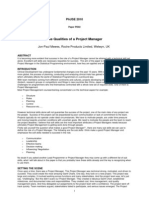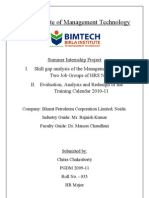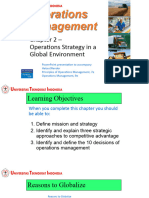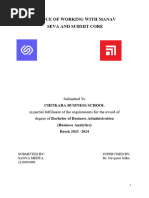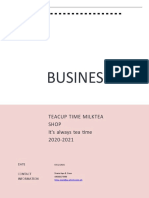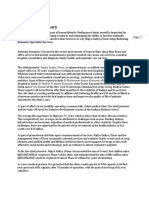Case Study OB2
Case Study OB2
Uploaded by
Ambika PhalkeCopyright:
Available Formats
Case Study OB2
Case Study OB2
Uploaded by
Ambika PhalkeOriginal Description:
Copyright
Available Formats
Share this document
Did you find this document useful?
Is this content inappropriate?
Copyright:
Available Formats
Case Study OB2
Case Study OB2
Uploaded by
Ambika PhalkeCopyright:
Available Formats
“Evolve to Excel” – Laying the foundation for a transformational Journey
About us:
Quick Heal is the market leader in the consumer segment while the company has been rapidly
ramping its presence in the enterprise business with brand ‘Seqrite’. Started in 1993 as an AV vendor,
the company has diversified to become an all-round player in cybersecurity with presence in B2C,
B2B and B2G segments.
Problem Statement:
To ensure that the organization is ready to go to the next stage, the management was keen on creating
a progressive organization design that makes the organization future ready and also responds to the
current business challenges. The objective of this was to build a product organization design in line
with strategy, create an internal talent pool and clear career paths.
Approach:“Evolve to Excel” is the transformation of Quick Heal
culture and organization from a Grade-centric to a role-centric
organization. This helped to focus on professional identities rather than
Grades; be more effective in assigning the right people to the right
project at the right time; and provide employees with visibility into
their career opportunities. The journey was divided into 2 phases,
Phase 1- Role Architecture- A foundation for a meaningful career. In
this phase, Unique roles were identified and from 300+ roles in the
organization this came down 116 unique roles and from 15 grades it
came down to 10 grades structure. In Phase 2-Learning Architecture,
for all unique roles, technical and behavioral competencies were
identified along with the desired proficiency level.
Project Team:
The project started in January ’19 and was driven by the in-house cross-functional team. Post
discussion with senior leadership, the CHRO along with project manager and HRBP’s prepared the
team charter, “The Evolve to Excel” journey plan was discussed with the team and the objective,
scope of work for every individual along with the expectations and milestones were defined. The
project was led by the CHRO and L&D (Project Manager). HRBP’s reached out to the HoDs for 4-5
nominations from each department who would be part of the core team. Every individual was given
the responsibility to manage the end-to-end execution of the project plan for the respective BU’s. The
HRBP’s reached out to each other or the core team for any support.
Execution:
The CHRO, project manager along with HRBP’s planned meetings with every BU and their senior
leadership to onboard them on the project and gain buy-in. Initially, the core team was skeptical of the
project’s success as this was a big change for the organisation and the team was inexperienced. The
CHRO conducted trainings and referred a lot of learning material to the team. HRBP’s worked closely
with the respective BU to work on identifying unique roles, JDs and career paths. The process
required a comprehensive review of the existing roles and aligned them to the existing structure and
ensured an appropriate fitment of the employees to the roles. During the employee mapping phase,
there was a lot of push-back from the managers and HoDs due to roles being merged which led to re-
titling of roles. On a regular basis organization wide communication was shared on the progress of the
project, regular project team meetings conducted, road shows and workshops for employees and
managers were conducted to help improve employee buy-in for organizational wide change.
Conclusion: The entire exercise was successfully completed and implemented within 5 months by the
project team in the organisation. This project helped create a foundation for a meaningful career
which led to the beginning of a transformational journey at Quick Heal.
TEAM – Together Everyone Achieves More
You might also like
- Project Welingkar 1ST YearDocument59 pagesProject Welingkar 1ST YearChirag Kapoor40% (10)
- 2.4.1 Project - Creating A Product (Project)Document12 pages2.4.1 Project - Creating A Product (Project)yezoo2006No ratings yet
- Teamwork Training OutlineDocument3 pagesTeamwork Training OutlineRasya FiezaNo ratings yet
- Leadership Development - Full PaperDocument9 pagesLeadership Development - Full PaperJayakumar ChandrasekarNo ratings yet
- Final Project BBDocument88 pagesFinal Project BBujwaljaiswalNo ratings yet
- Leadership and Management Compare and Contrast PaperDocument13 pagesLeadership and Management Compare and Contrast PaperGinger Rosseter100% (1)
- Ikea Entry Into IndiaDocument12 pagesIkea Entry Into IndiaJohn Baptist100% (1)
- Project ManagementDocument10 pagesProject ManagementbijubijayNo ratings yet
- Case StudyDocument15 pagesCase Studykaszulu1No ratings yet
- Receiving Job Descriptions/ Requisition Sourcing / Screening of ResumesDocument6 pagesReceiving Job Descriptions/ Requisition Sourcing / Screening of ResumesgeetanilankarNo ratings yet
- Qualities of Project ManagerDocument6 pagesQualities of Project ManagerVivi Vikash100% (1)
- Apache Metals, Inc. Question 01 What Problems Can You See in The Way Project Managers Were Assigned in The Past?Document10 pagesApache Metals, Inc. Question 01 What Problems Can You See in The Way Project Managers Were Assigned in The Past?Faria AnjumNo ratings yet
- Competency Map at Land TDocument4 pagesCompetency Map at Land TStany D'melloNo ratings yet
- HahaDocument11 pagesHahaAdrian MateiNo ratings yet
- Ogl 482 - Networking PlanDocument23 pagesOgl 482 - Networking Planapi-650736231No ratings yet
- OpexDocument16 pagesOpexMAFEROSONo ratings yet
- Section 1 - Group 06 - Beijing Eaps Consultings IncDocument11 pagesSection 1 - Group 06 - Beijing Eaps Consultings IncSoumendu Mukhopadhyay100% (1)
- Oil & Gas - BPCL TrainingDocument58 pagesOil & Gas - BPCL TraininguraviabvpNo ratings yet
- Neelam Repaired) Repaired)Document28 pagesNeelam Repaired) Repaired)Siddhant GuptaNo ratings yet
- Anindya SheeDocument4 pagesAnindya SheeBHIKHU DHADHINo ratings yet
- Mol PakistanDocument14 pagesMol PakistanMinhas KhanNo ratings yet
- Building Capability To Support Project Management As Mainstream DisciplineDocument17 pagesBuilding Capability To Support Project Management As Mainstream DisciplineMaven Training100% (1)
- 11fdf9 - Building The Workforce of Tomorrow TodayDocument5 pages11fdf9 - Building The Workforce of Tomorrow TodayAdnan ShaukatNo ratings yet
- Career PlanningDocument6 pagesCareer PlanningNaresh Prasad ShresthaNo ratings yet
- Individual PaperDocument9 pagesIndividual Papersarahkhairallah2020No ratings yet
- Ist626 Strategic Thinking Project DefinitionDocument5 pagesIst626 Strategic Thinking Project Definitionapi-451428750No ratings yet
- Proposal For The - Hot Shoes - Role Interchange ProgramDocument4 pagesProposal For The - Hot Shoes - Role Interchange ProgrampmpworkdeskNo ratings yet
- Career PlanningDocument43 pagesCareer PlanningkalvinonyaNo ratings yet
- Ed Ebreo - Basic Leadership and Management WorkshopDocument5 pagesEd Ebreo - Basic Leadership and Management WorkshopEdwin Ebreo100% (1)
- Projman Assignment3Document3 pagesProjman Assignment3kyle rajuNo ratings yet
- Soft Skills On Project Management Research PaperDocument17 pagesSoft Skills On Project Management Research PaperGary PitNo ratings yet
- 2P-Ahmed Mohamed Hafed-HR MidTermDocument7 pages2P-Ahmed Mohamed Hafed-HR MidTermAhmed HafedNo ratings yet
- Project On Employee SatisfactionDocument71 pagesProject On Employee SatisfactionvinaykulagodNo ratings yet
- SOP RevisionDocument3 pagesSOP RevisionfaisalnhussainNo ratings yet
- CV For NGO-FDocument4 pagesCV For NGO-FSyed Imtiaz Ahmed UsamaNo ratings yet
- Strategic Planning WorkshopDocument6 pagesStrategic Planning WorkshopWilson Bautista100% (1)
- Succession Planning HRDocument12 pagesSuccession Planning HRbetallion44No ratings yet
- Why Do You Say That Project Management Is The Best Method of Implementing ChangeDocument10 pagesWhy Do You Say That Project Management Is The Best Method of Implementing ChangeFaisal HameedNo ratings yet
- Internship Project Report - Shweta - FinalDocument101 pagesInternship Project Report - Shweta - FinalshwetaNo ratings yet
- HR CareersDocument8 pagesHR CareersFama aNo ratings yet
- Career Planning & Succession Planning: Prof. Preeti BhaskarDocument40 pagesCareer Planning & Succession Planning: Prof. Preeti BhaskarDrNeeraj N. RanaNo ratings yet
- 4 P's ExerciseDocument5 pages4 P's ExerciseTitania Shinri-GakuNo ratings yet
- Literature Review On Career Planning and DevelopmentDocument8 pagesLiterature Review On Career Planning and Developmentea6p1e99No ratings yet
- Case StudyDocument2 pagesCase StudyAnkit_4668No ratings yet
- Organization Theories For Effective Business ManagementDocument8 pagesOrganization Theories For Effective Business ManagementJoel C. TubilanNo ratings yet
- Career Development For Middle Level Employee in Edelweiss Tokio Life InsuranceDocument53 pagesCareer Development For Middle Level Employee in Edelweiss Tokio Life InsuranceShobiga VNo ratings yet
- 8 HR Develpoment-2Document27 pages8 HR Develpoment-2Sherif KhalifaNo ratings yet
- Topic-Orientation and Placement: Laxmi KumariDocument9 pagesTopic-Orientation and Placement: Laxmi Kumariguinui489No ratings yet
- MSBPDocument27 pagesMSBPFaraz50% (2)
- Managing People (CH-4)Document10 pagesManaging People (CH-4)eyasuNo ratings yet
- Individual Assignment ScribdDocument4 pagesIndividual Assignment ScribdDharna KachrooNo ratings yet
- Career ManagementDocument43 pagesCareer ManagementAmritMohanty100% (1)
- WSDOT LeadershipDevelopmentSuccessionPlanningReportDocument54 pagesWSDOT LeadershipDevelopmentSuccessionPlanningReportgohildigu90No ratings yet
- GRFGDocument10 pagesGRFGguinui489No ratings yet
- CE115 Engineering Management PDFDocument25 pagesCE115 Engineering Management PDFAshuriko Kazu100% (1)
- Organizational BehaviourDocument18 pagesOrganizational BehaviourPrasoon ShrivastavaNo ratings yet
- Prosci Onsite Training Change MGMTDocument8 pagesProsci Onsite Training Change MGMTHenrique Narciso100% (1)
- Project On WiproDocument12 pagesProject On WiproMeera HansNo ratings yet
- Manajemen Proyek IT - Tugas 2Document3 pagesManajemen Proyek IT - Tugas 2Evan BenedictNo ratings yet
- Career Development For Middle Level Employee in Edelweiss Tokio Life InsuranceDocument53 pagesCareer Development For Middle Level Employee in Edelweiss Tokio Life InsuranceFairyjaanNo ratings yet
- The Irreverent Guide to Project Management: An Agile Approach to Enterprise Project Management, Version 5.0From EverandThe Irreverent Guide to Project Management: An Agile Approach to Enterprise Project Management, Version 5.0No ratings yet
- Sec 6, Sec 8 and Sec 9Document5 pagesSec 6, Sec 8 and Sec 9Ambika PhalkeNo ratings yet
- 1: (Meaning - Succession Planning)Document6 pages1: (Meaning - Succession Planning)Ambika PhalkeNo ratings yet
- MactempDocument3 pagesMactempAmbika PhalkeNo ratings yet
- IN-Class Exercise 1 Organizational Goals and Training NeedsDocument1 pageIN-Class Exercise 1 Organizational Goals and Training NeedsAmbika PhalkeNo ratings yet
- NumericalsDocument7 pagesNumericalsAmbika PhalkeNo ratings yet
- Notes - CBHRMDocument7 pagesNotes - CBHRMAmbika PhalkeNo ratings yet
- Indigo-Post Covid Strategy and InitiativesDocument2 pagesIndigo-Post Covid Strategy and InitiativesAmbika PhalkeNo ratings yet
- Chapter 2Document17 pagesChapter 2maiNo ratings yet
- EMIS Insights - Colombia Consumer Goods and Retail Sector Report H1 2024Document37 pagesEMIS Insights - Colombia Consumer Goods and Retail Sector Report H1 2024CAMILO ANDRES ROBLEDO CUELLARNo ratings yet
- Business-Plan - DoneDocument12 pagesBusiness-Plan - DoneArni Allyson ValenciaNo ratings yet
- Principles of Marketing: Dina El Tabey Mariam Abou-YoussefDocument63 pagesPrinciples of Marketing: Dina El Tabey Mariam Abou-YoussefKush GuptaNo ratings yet
- Digital Marketing - Amit, MrinalDocument18 pagesDigital Marketing - Amit, MrinalLearner's LicenseNo ratings yet
- Internship ReportDocument42 pagesInternship Reportmehak3066.bbaa21No ratings yet
- Answer ANY THREE Questions: Chandres Tejura BUS 239 Management Accounting For Decision MakingDocument9 pagesAnswer ANY THREE Questions: Chandres Tejura BUS 239 Management Accounting For Decision MakingrahimNo ratings yet
- The Upstart's AssaultDocument8 pagesThe Upstart's AssaultPrashant LaleNo ratings yet
- The Effect of Celebrity Endorsement On Consumer Buying BehaviourDocument5 pagesThe Effect of Celebrity Endorsement On Consumer Buying BehavioursariikaNo ratings yet
- Course Syllabus in Marketing Management: Republic of The PhilippinesDocument11 pagesCourse Syllabus in Marketing Management: Republic of The Philippineschicken pork adoboNo ratings yet
- Foreign ExchangeDocument21 pagesForeign Exchangedamodar.kunchala1No ratings yet
- Marketing For Small BusinessesDocument33 pagesMarketing For Small BusinessesJenemarNo ratings yet
- Brl-004 Customerservice Management: Content Digitized by Egyankosh, IgnouDocument13 pagesBrl-004 Customerservice Management: Content Digitized by Egyankosh, IgnouShivatiNo ratings yet
- 0.1 - Ryanair Operational Objectives - ANSWERDocument2 pages0.1 - Ryanair Operational Objectives - ANSWERGary ANo ratings yet
- Analyse The Case Facts in Terms of Customer, Company, Competitor, Context and CollaboratorsDocument9 pagesAnalyse The Case Facts in Terms of Customer, Company, Competitor, Context and Collaboratorsshweta singh100% (1)
- Syed Rehman Resume 2021Document3 pagesSyed Rehman Resume 2021h71200263No ratings yet
- Date Sheet of Semester-End-Exam Main/Back March-2023: Page 1 of 6 Director Distance EducationDocument6 pagesDate Sheet of Semester-End-Exam Main/Back March-2023: Page 1 of 6 Director Distance EducationMjarma5253No ratings yet
- PepsiCo SWOT MATRIX - For MergeDocument2 pagesPepsiCo SWOT MATRIX - For MergeJKNo ratings yet
- Busines S: Teacup Time Milktea Shop It's Always Tea Time 2020-2021Document11 pagesBusines S: Teacup Time Milktea Shop It's Always Tea Time 2020-2021Kimberly Kyle CatrizNo ratings yet
- Business StudiesDocument22 pagesBusiness StudiesmhindutadiwaNo ratings yet
- Process Focus QuizletDocument7 pagesProcess Focus QuizletSeneca GonzalesNo ratings yet
- ENT530 (Company Profile & Environmental Analysis)Document7 pagesENT530 (Company Profile & Environmental Analysis)Shira EjatNo ratings yet
- PETCONOMYDocument44 pagesPETCONOMYMaz Maz MazNo ratings yet
- The Direct-to-Consumer Guide: How To Start Selling DTCDocument31 pagesThe Direct-to-Consumer Guide: How To Start Selling DTCShubhashish100% (1)
- Team Building Literature ReviewDocument7 pagesTeam Building Literature Reviewafmzkbysdbblih100% (1)
- Kettering Business PlanDocument22 pagesKettering Business PlanfrankNo ratings yet
- TOP100 2019 ExecutiveSummary EnglishDocument16 pagesTOP100 2019 ExecutiveSummary EnglishceciliaNo ratings yet











